材料概论
- 格式:doc
- 大小:47.00 KB
- 文档页数:9


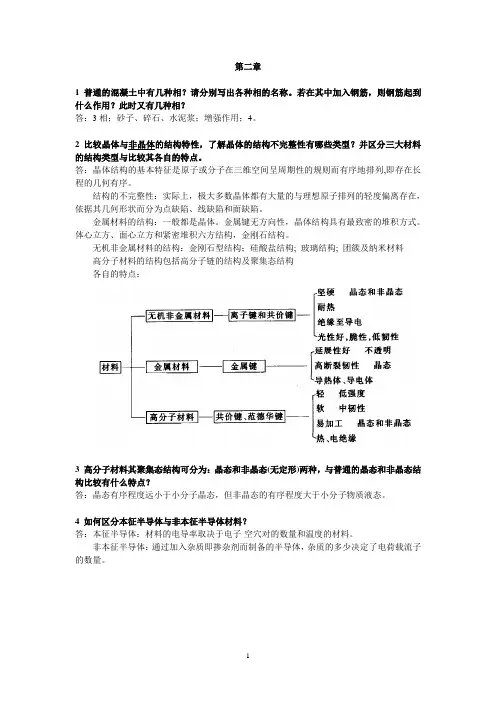
第二章1 普通的混凝土中有几种相?请分别写出各种相的名称。
若在其中加入钢筋,则钢筋起到什么作用?此时又有几种相?答:3相;砂子、碎石、水泥浆;增强作用;4。
2 比较晶体与非晶体的结构特性,了解晶体的结构不完整性有哪些类型?并区分三大材料的结构类型与比较其各自的特点。
答:晶体结构的基本特征是原子或分子在三维空间呈周期性的规则而有序地排列,即存在长程的几何有序。
结构的不完整性:实际上,极大多数晶体都有大量的与理想原子排列的轻度偏离存在,依据其几何形状而分为点缺陷、线缺陷和面缺陷。
金属材料的结构:一般都是晶体。
金属键无方向性,晶体结构具有最致密的堆积方式。
体心立方、面心立方和紧密堆积六方结构,金刚石结构。
无机非金属材料的结构:金刚石型结构;硅酸盐结构; 玻璃结构; 团簇及纳米材料高分子材料的结构包括高分子链的结构及聚集态结构各自的特点:3 高分子材料其聚集态结构可分为:晶态和非晶态(无定形)两种,与普通的晶态和非晶态结构比较有什么特点?答:晶态有序程度远小于小分子晶态,但非晶态的有序程度大于小分子物质液态。
4 如何区分本征半导体与非本征半导体材料?答:本征半导体:材料的电导率取决于电子-空穴对的数量和温度的材料。
非本征半导体:通过加入杂质即掺杂剂而制备的半导体,杂质的多少决定了电荷载流子的数量。
5 极大多数晶体实际上都存在有种种与理想原子排列的轻度偏离,依据结构不完整性的几何形状可分为哪几种缺陷类型?按溶质原子在溶剂晶格中的位置不同,固溶体可分成哪几种类型?答:依据其几何形状而分为点缺陷、线缺陷和面缺陷。
按溶质原子在溶剂晶格中的位置不同,固溶体可分成:置换型固溶体(或称取代型):溶剂A晶格中的原子被溶质B的原子取代所形成的固溶体。
原子A同B的大小要大致相同。
填隙型固溶体(也称间隙型):在溶剂A的晶格间隙内有溶质B的原子填入(溶入)所形成的固溶体。
B原子必须是充分小的,如C和N等是典型的溶质原子。
6 比较热塑性高分子材料和热固性高分子材料的结构特点,并说明由于结构的不同对其性能的影响。
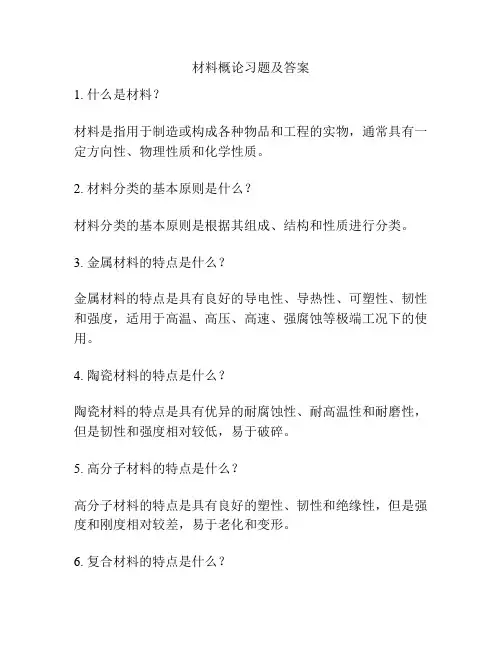
材料概论习题及答案
1. 什么是材料?
材料是指用于制造或构成各种物品和工程的实物,通常具有一定方向性、物理性质和化学性质。
2. 材料分类的基本原则是什么?
材料分类的基本原则是根据其组成、结构和性质进行分类。
3. 金属材料的特点是什么?
金属材料的特点是具有良好的导电性、导热性、可塑性、韧性和强度,适用于高温、高压、高速、强腐蚀等极端工况下的使用。
4. 陶瓷材料的特点是什么?
陶瓷材料的特点是具有优异的耐腐蚀性、耐高温性和耐磨性,但是韧性和强度相对较低,易于破碎。
5. 高分子材料的特点是什么?
高分子材料的特点是具有良好的塑性、韧性和绝缘性,但是强度和刚度相对较差,易于老化和变形。
6. 复合材料的特点是什么?
复合材料的特点是将两种或两种以上不同材料经过特定的工艺组合而成,具有优异的性能,可以满足不同领域特定的需求。
7. 工程材料的应用范围包括哪些方面?
工程材料的应用范围包括建筑、装修、交通运输、电子、能源、医疗等方面。
8. 应该如何选取合适的材料?
应该根据使用环境、工作条件、使用要求等多方面因素来选取合适的材料,同时考虑材料的成本、可行性和环境影响等方面因素。
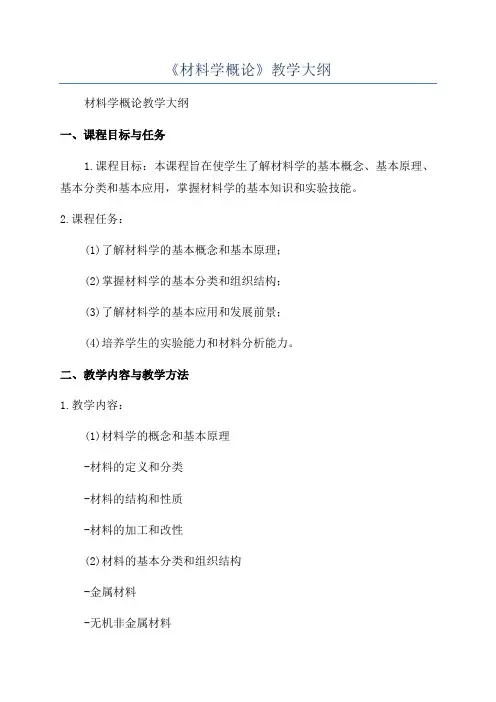
《材料学概论》教学大纲材料学概论教学大纲一、课程目标与任务1.课程目标:本课程旨在使学生了解材料学的基本概念、基本原理、基本分类和基本应用,掌握材料学的基本知识和实验技能。
2.课程任务:(1)了解材料学的基本概念和基本原理;(2)掌握材料学的基本分类和组织结构;(3)了解材料学的基本应用和发展前景;(4)培养学生的实验能力和材料分析能力。
二、教学内容与教学方法1.教学内容:(1)材料学的概念和基本原理-材料的定义和分类-材料的结构和性质-材料的加工和改性(2)材料的基本分类和组织结构-金属材料-无机非金属材料-有机材料(3)材料学的基本应用和发展前景-材料科学与工程学的基本研究方向-材料在工业、医学、航空航天等领域的应用(4)材料学的实验技能和分析方法-材料的制备和加工技术-材料的结构和性能的表征方法2.教学方法:(1)讲授法:通过讲述材料学的基本概念、原理和分类,引导学生了解材料学的基本知识;(2)案例分析法:通过分析实际案例,让学生了解材料学的应用和发展前景;(3)实验教学法:通过实验教学,培养学生的实验能力和材料分析能力;(4)讨论与互动:促进学生思维的活跃,通过讨论和互动形式培养学生的问题解决能力。
三、教学评估与考核方法1.教学评估方法:(1)平时成绩:包括课堂表现、作业完成情况等;(2)实验报告:评估学生的实验能力和材料分析能力;(3)期末考试:考察学生对课程内容的掌握程度。
2.考核方法:(1)结合平时成绩、实验报告和期末考试成绩综合评定学生的学习成绩;(2)根据学生的学习情况,进行个别辅导和帮助,提高学生的学习效果。
四、教材与参考书目1.教材:2.参考书目:(1)《材料科学基础》主编:XXX,出版社:XXX,出版时间:XXXX。
(2)《材料工程概论》主编:XXX,出版社:XXX,出版时间:XXXX。
五、教学进度安排本课程总学时为XX学时,具体的教学进度安排如下:第一周:材料学的概念和基本原理(X学时)-材料的定义和分类-材料的结构和性质-材料的加工和改性第二周:材料的基本分类和组织结构(X学时)-金属材料-无机非金属材料-有机材料第三周:材料学的基本应用和发展前景(X学时)-材料科学与工程学的基本研究方向-材料在工业、医学、航空航天等领域的应用第四周:材料学的实验技能和分析方法(X学时)-材料的制备和加工技术-材料的结构和性能的表征方法注:具体的教学进度可能根据实际情况进行调整。

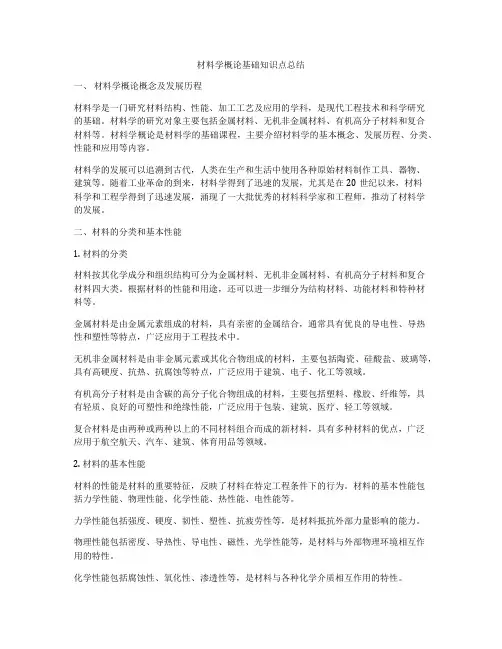
材料学概论基础知识点总结一、材料学概论概念及发展历程材料学是一门研究材料结构、性能、加工工艺及应用的学科,是现代工程技术和科学研究的基础。
材料学的研究对象主要包括金属材料、无机非金属材料、有机高分子材料和复合材料等。
材料学概论是材料学的基础课程,主要介绍材料学的基本概念、发展历程、分类、性能和应用等内容。
材料学的发展可以追溯到古代,人类在生产和生活中使用各种原始材料制作工具、器物、建筑等。
随着工业革命的到来,材料学得到了迅速的发展,尤其是在20世纪以来,材料科学和工程学得到了迅速发展,涌现了一大批优秀的材料科学家和工程师,推动了材料学的发展。
二、材料的分类和基本性能1. 材料的分类材料按其化学成分和组织结构可分为金属材料、无机非金属材料、有机高分子材料和复合材料四大类。
根据材料的性能和用途,还可以进一步细分为结构材料、功能材料和特种材料等。
金属材料是由金属元素组成的材料,具有亲密的金属结合,通常具有优良的导电性、导热性和塑性等特点,广泛应用于工程技术中。
无机非金属材料是由非金属元素或其化合物组成的材料,主要包括陶瓷、硅酸盐、玻璃等,具有高硬度、抗热、抗腐蚀等特点,广泛应用于建筑、电子、化工等领域。
有机高分子材料是由含碳的高分子化合物组成的材料,主要包括塑料、橡胶、纤维等,具有轻质、良好的可塑性和绝缘性能,广泛应用于包装、建筑、医疗、轻工等领域。
复合材料是由两种或两种以上的不同材料组合而成的新材料,具有多种材料的优点,广泛应用于航空航天、汽车、建筑、体育用品等领域。
2. 材料的基本性能材料的性能是材料的重要特征,反映了材料在特定工程条件下的行为。
材料的基本性能包括力学性能、物理性能、化学性能、热性能、电性能等。
力学性能包括强度、硬度、韧性、塑性、抗疲劳性等,是材料抵抗外部力量影响的能力。
物理性能包括密度、导热性、导电性、磁性、光学性能等,是材料与外部物理环境相互作用的特性。
化学性能包括腐蚀性、氧化性、渗透性等,是材料与各种化学介质相互作用的特性。
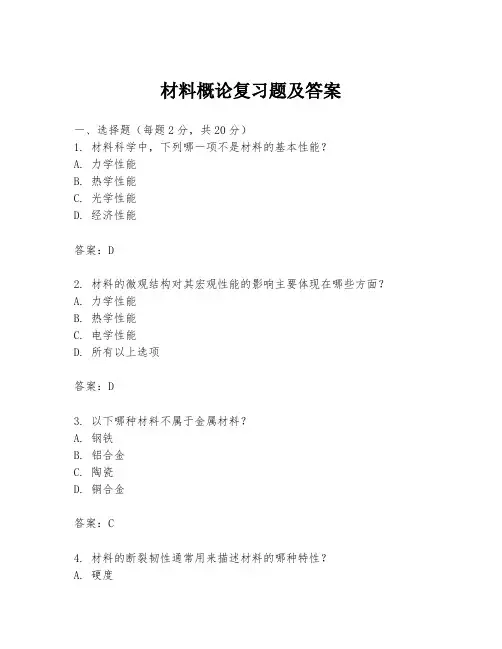
材料概论复习题及答案一、选择题(每题2分,共20分)1. 材料科学中,下列哪一项不是材料的基本性能?A. 力学性能B. 热学性能C. 光学性能D. 经济性能答案:D2. 材料的微观结构对其宏观性能的影响主要体现在哪些方面?A. 力学性能B. 热学性能C. 电学性能D. 所有以上选项答案:D3. 以下哪种材料不属于金属材料?A. 钢铁B. 铝合金C. 陶瓷D. 铜合金答案:C4. 材料的断裂韧性通常用来描述材料的哪种特性?A. 硬度B. 韧性C. 脆性D. 弹性答案:B5. 材料的疲劳寿命主要受哪些因素的影响?A. 材料的强度B. 材料的硬度C. 应力集中D. 所有以上选项答案:D6. 材料的热处理过程中,淬火的主要目的是?A. 提高硬度B. 提高韧性C. 提高耐腐蚀性D. 提高导电性答案:A7. 以下哪种材料具有最好的导电性能?A. 塑料B. 橡胶C. 玻璃D. 银答案:D8. 材料的塑性变形通常发生在哪个温度区间?A. 低于玻璃化转变温度B. 在玻璃化转变温度附近C. 高于玻璃化转变温度D. 以上都不对答案:C9. 材料的断裂模式主要分为哪两种?A. 拉伸断裂和压缩断裂B. 剪切断裂和拉伸断裂C. 脆性断裂和韧性断裂D. 疲劳断裂和蠕变断裂答案:C10. 材料的硬度通常通过哪种测试来测量?A. 拉伸测试B. 压缩测试C. 硬度测试D. 冲击测试答案:C二、填空题(每空1分,共20分)1. 材料的_______性能是指材料在受到外力作用时,抵抗变形和破坏的能力。
答案:力学2. 材料的热膨胀系数是指材料在单位温度变化下长度变化的_______。
答案:比例3. 金属材料的强化机制主要包括_______强化、_______强化和_______强化。
答案:固溶,加工,沉淀4. 陶瓷材料的主要特点是_______、_______和_______。
答案:高硬度,高熔点,低热导率5. 聚合物材料的玻璃化转变温度是指聚合物从_______状态转变为_______状态的温度。
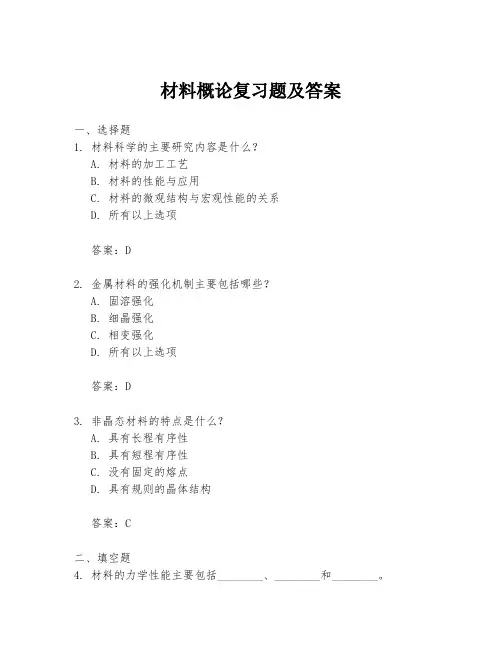
材料概论复习题及答案一、选择题1. 材料科学的主要研究内容是什么?A. 材料的加工工艺B. 材料的性能与应用C. 材料的微观结构与宏观性能的关系D. 所有以上选项答案:D2. 金属材料的强化机制主要包括哪些?A. 固溶强化B. 细晶强化C. 相变强化D. 所有以上选项答案:D3. 非晶态材料的特点是什么?A. 具有长程有序性B. 具有短程有序性C. 没有固定的熔点D. 具有规则的晶体结构答案:C二、填空题4. 材料的力学性能主要包括________、________和________。
答案:硬度、韧性、弹性5. 陶瓷材料通常具有________、________和________等特性。
答案:高硬度、高熔点、耐腐蚀三、简答题6. 简述材料的分类及其特点。
答案:材料通常分为金属材料、无机非金属材料、有机高分子材料和复合材料。
金属材料具有良好的导电性和导热性,较高的强度和韧性。
无机非金属材料如陶瓷和玻璃,具有高硬度、高熔点和耐腐蚀性。
有机高分子材料具有良好的弹性和可塑性,易于加工。
复合材料结合了两种或两种以上材料的优点,具有更优异的性能。
四、论述题7. 论述材料科学在现代科技发展中的重要性。
答案:材料科学是现代科技发展的重要基础和推动力。
随着科技的进步,对材料的性能要求越来越高,新材料的研究和开发成为科技发展的关键。
例如,在航空航天领域,轻质高强度的材料是实现飞行器性能提升的关键;在电子行业,高性能的半导体材料是推动电子设备小型化、功能化的重要保障;在生物医学领域,生物兼容性好的材料对于人工器官的制造至关重要。
因此,材料科学的发展直接关系到科技进步和人类生活质量的提高。
五、计算题8. 某金属材料的屈服强度为300 MPa,抗拉强度为500 MPa,若要计算其弹性模量,需要知道其应力-应变曲线上的哪两个点?答案:要计算弹性模量,需要知道屈服点的应力和应变,以及弹性极限的应力和应变。
屈服强度为300 MPa时对应的应变点,以及抗拉强度为500 MPa时对应的应变点。
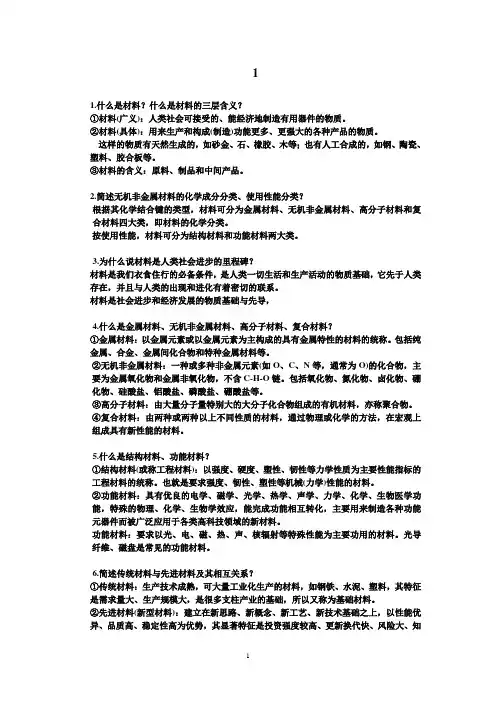
11.什么是材料?什么是材料的三层含义?①材料(广义):人类社会可接受的、能经济地制造有用器件的物质。
②材料(具体):用来生产和构成(制造)功能更多、更强大的各种产品的物质。
这样的物质有天然生成的,如砂金、石、橡胶、木等;也有人工合成的,如钢、陶瓷、塑料、胶合板等。
③材料的含义:原料、制品和中间产品。
2.简述无机非金属材料的化学成分分类、使用性能分类?根据其化学结合键的类型,材料可分为金属材料、无机非金属材料、高分子材料和复合材料四大类,即材料的化学分类。
按使用性能,材料可分为结构材料和功能材料两大类。
3.为什么说材料是人类社会进步的里程碑?材料是我们衣食住行的必备条件,是人类一切生活和生产活动的物质基础,它先于人类存在,并且与人类的出现和进化有着密切的联系。
材料是社会进步和经济发展的物质基础与先导,4.什么是金属材料、无机非金属材料、高分子材料、复合材料?①金属材料:以金属元素或以金属元素为主构成的具有金属特性的材料的统称。
包括纯金属、合金、金属间化合物和特种金属材料等。
②无机非金属材料:一种或多种非金属元素(如O、C、N等,通常为O)的化合物,主要为金属氧化物和金属非氧化物,不含C-H-O链。
包括氧化物、氮化物、卤化物、硼化物、硅酸盐、铝酸盐、磷酸盐、硼酸盐等。
③高分子材料:由大量分子量特别大的大分子化合物组成的有机材料,亦称聚合物。
④复合材料:由两种或两种以上不同性质的材料,通过物理或化学的方法,在宏观上组成具有新性能的材料。
5.什么是结构材料、功能材料?①结构材料(或称工程材料):以强度、硬度、塑性、韧性等力学性质为主要性能指标的工程材料的统称。
也就是要求强度、韧性、塑性等机械(力学)性能的材料。
②功能材料:具有优良的电学、磁学、光学、热学、声学、力学、化学、生物医学功能,特殊的物理、化学、生物学效应,能完成功能相互转化,主要用来制造各种功能元器件而被广泛应用于各类高科技领域的新材料。
功能材料:要求以光、电、磁、热、声、核辐射等特殊性能为主要功用的材料。
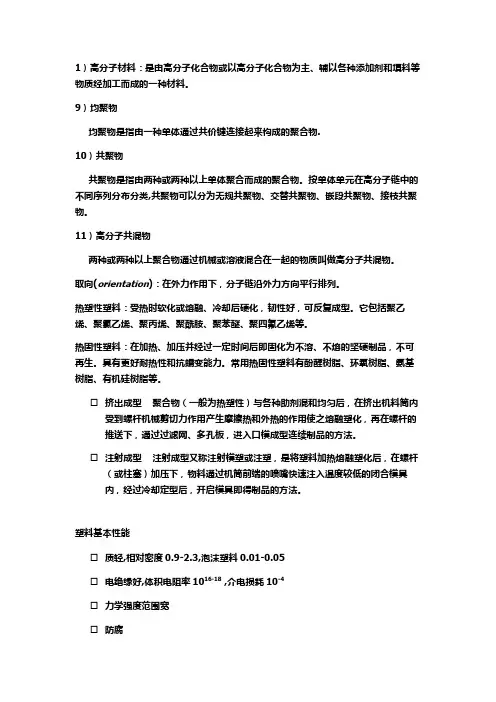
1)高分子材料:是由高分子化合物或以高分子化合物为主、辅以各种添加剂和填料等物质经加工而成的一种材料。
9)均聚物均聚物是指由一种单体通过共价键连接起来构成的聚合物.10)共聚物共聚物是指由两种或两种以上单体聚合而成的聚合物。
按单体单元在高分子链中的不同序列分布分类,共聚物可以分为无规共聚物、交替共聚物、嵌段共聚物、接枝共聚物。
11)高分子共混物两种或两种以上聚合物通过机械或溶液混合在一起的物质叫做高分子共混物。
取向(orientation):在外力作用下,分子链沿外力方向平行排列。
热塑性塑料:受热时软化或熔融、冷却后硬化,韧性好,可反复成型。
它包括聚乙烯、聚氯乙烯、聚丙烯、聚酰胺、聚苯醚、聚四氟乙烯等。
热固性塑料:在加热、加压并经过一定时间后即固化为不溶、不熔的坚硬制品,不可再生。
具有更好耐热性和抗蠕变能力。
常用热固性塑料有酚醛树脂、环氧树脂、氨基树脂、有机硅树脂等。
☐挤出成型聚合物(一般为热塑性)与各种助剂混和均匀后,在挤出机料筒内受到螺杆机械剪切力作用产生摩擦热和外热的作用使之熔融塑化,再在螺杆的推送下,通过过滤网、多孔板,进入口模成型连续制品的方法。
☐注射成型注射成型又称注射模塑或注塑,是将塑料加热熔融塑化后,在螺杆(或柱塞)加压下,物料通过机筒前端的喷嘴快速注入温度较低的闭合模具内,经过冷却定型后,开启模具即得制品的方法。
塑料基本性能☐质轻,相对密度0.9-2.3,泡沫塑料0.01-0.05☐电绝缘好,体积电阻率1016-18 ,介电损耗10-4☐力学强度范围宽☐防腐☐隔热☐成型加工性能好☐减震,消音,透光不足:耐热差,力学强度小于金属,导热差,膨胀系数大,易变形,易燃,蠕变,冷流,疲劳等。
塑料组成与作用I 树脂(60-100%)决定塑料基本性能粘结作用II 助剂(提高性能、降低成本)A 热稳定剂:金属盐类,皂类,有机锡,环氧化油光稳定剂:UV吸收剂,光屏蔽剂,猝灭剂,自由基捕捉剂B 增塑剂:邻苯二甲酸酯,磷酸酯类C 润滑剂:硬脂酸(酯),石蜡D 填充剂/增强剂:碳酸钙,滑石粉,木粉,短纤维E 改性剂:ACR,MBSF 固化剂:胺类G 其他:如发泡,阻燃,抗静电,防腐,着色等PE聚乙烯的结构:聚乙烯是线性聚合物,由于C-C链是柔性链,因而PE是柔性很好的热塑性聚合物。
材料学概论重点.doc材料学概论是材料学的入门课程,主要介绍材料科学的基本概念、理论和方法。
本文将重点介绍材料学概论中的一些重要内容。
1. 材料的基本分类材料可以按照其组成、特性及用途等方面进行分类。
从组成角度来看,材料可以分为金属材料、无机非金属材料和有机高分子材料等。
从特性角度来看,材料可以分为金属材料、陶瓷材料、塑料材料、纤维材料和半导体材料等。
从用途角度来看,材料可以分为结构材料、功能材料和生物材料等。
2. 材料的物理性质材料的物理性质包括密度、热力学性质、光学性质、磁性和导电性等。
密度是指单位体积内的质量,可以反映材料的重量和体积之间的关系。
热力学性质包括热容、热导率、热膨胀系数等,这些指标可以反映材料的热响应能力。
光学性质包括折射率、吸收系数、反射率等,可以反映材料的光传播和吸收能力。
磁性是指材料对磁场的响应能力,主要包括铁磁性、顺磁性和抗磁性。
导电性是指材料对电场的响应,主要包括导电材料和绝缘材料。
材料的化学性质包括化学组成、化学稳定性、反应性等。
化学组成是指材料中元素或化合物的种类和相对量,可以决定材料的性质和用途。
化学稳定性是指材料在不同环境下的稳定性,主要包括氧化性、还原性和腐蚀性等。
反应性是指材料与其他物质发生各种化学反应的能力。
4. 材料的制备和表征材料的制备包括物理制备和化学制备两类。
物理制备包括熔融法、凝固法、沉淀法和气相沉积法等,化学制备包括溶胶-凝胶法、水热法、电化学沉积法等。
材料的表征主要包括物理性质表征和化学性质表征。
物理性质表征主要包括形貌表征、结构表征和力学性质表征等,化学性质表征主要包括元素定量分析、化学反应等。
5. 材料的应用材料的应用涉及到多个领域,主要包括电子材料、光学材料、结构材料、生物材料等。
电子材料包括半导体材料、金属材料和磁性材料等,可以用于电子元件的制造;光学材料包括玻璃、透镜等,可以用于光学仪器和装置等;结构材料包括钢铁、混凝土等,可用于建筑和工程结构;生物材料包括医用材料和食品包装材料等。
材料学概论材料学是一门研究材料的学科,探索材料的结构、性质、制备、加工和应用等方面。
它是工程学、物理学和化学的交叉学科,对于现代科技和工业的发展起到了至关重要的作用。
材料学的研究对象包括金属、陶瓷、聚合物、复合材料等各种种类的材料。
它的研究内容主要包括:材料结构的表征和评价、材料性能的测试和气体快鈬决面,并且程度上,对材料的制备和加工技术,材料退火和热处理等也进行了研究。
材料的结构是研究材料性质的基础,它决定了材料的物理、化学和力学性质。
通过各种手段,如显微镜观察、X射线衍射、电子束衍射等,可以对材料的内部结构进行研究。
材料的性质包括热性能、力学性能、电性能、光学性能等。
通过实验测试和数学模型分析,可以对不同材料的各种性质进行研究和评价,为材料选择和设计提供依据。
在材料的制备和加工方面,可以根据所需材料的特性和应用需求,选择合适的制备方法进行材料的合成。
常见的制备方法有熔炼、溶液法、溅射法等。
而加工方法则包括成型、锻造、热处理等。
这些技术旨在改变材料的形状、结构和性能,使其更符合使用要求。
材料的退火和热处理是改变材料结构和性能的重要方法。
退火是指将金属材料加热到一定温度并保持一段时间,然后缓慢冷却。
退火可以消除应力和缺陷,提高材料的延展性和塑性。
热处理则是对材料进行加热和冷却,以改变其组织结构和性能。
通过合理的退火和热处理工艺,可以提高材料的硬度、强度和耐腐蚀性等。
材料学的应用范围非常广泛。
在工程领域,它可以用来设计和优化材料,以满足不同工程的要求。
在新能源领域,材料学可以用来研究和开发高效的能源材料,如太阳能电池、储能材料等。
在生物医学领域,材料学可以用来研发生物材料,如人工关节、心脏支架等。
在电子领域,材料学可以用来研制新型的导电材料和半导体材料,推动电子技术的发展。
总之,材料学作为一门重要的学科,对于现代科技和工业的发展起到了不可或缺的作用。
通过对材料结构、性质、制备和加工等方面的研究,可以不断提高材料的性能,推动科技进步和社会发展。
作业11.人类使用材料的历史经历了哪些时代?答:人类使用材料的历史经历了石器时代、青铜器时代、铁器时代、水泥时代、钢时代、硅时代、新材料时代。
2.材料的化学(键)分类和使用性能分类?答:材料的化学(键)分类:金属材料、无机非金属材料、高分子材料、复合材料。
材料的使用性能分类:结构材料、功能材料。
3.什么是材料科学、材料工程、材料科学与工程?答:材料科学:一门以固体材料为研究对象,以固体物理、固体化学、热力学、动力学、量子力学、冶金、化工为理论基础的边缘交叉基础应用学科,是运用电子显微镜、X 射线衍射、热谱、电子离子探针等各种精密仪器和技术,探讨材料的组成、结构、制备工艺和加工使用过程与其机械、物理、化学性能之间的规律的一门基础应用学科。
材料工程:运用材料科学的理论知识和经验知识,为满足各种特定需要而发展、制备和改进各种材料的工艺技术。
材料科学与工程:研究材料的组成与结构、合成与制备(工艺)、性能、使用效能(用途)四者之间相互关系和规律的一门科学。
4.简述无机非金属材料及其特点?答:无机非金属材料是一种或多种非金属元素(如O、C、N等,通常为O)的化合物,主要为金属氧化物和金属非氧化物,不含C-H-O链。
无机非金属材料的特点:①组成:一种或多种非金属元素(如O、C、N等,通常为O)的化合物。
②结构:结合键主要为离子键、共价键或离子-共价混合键。
③性能:高熔点、高强度、耐磨损、高硬度、耐腐蚀和抗氧化的基本属性,宽广的导电性、导热性和透光性以及良好的铁电性、铁磁性和压电性,很差的延展性及耐冲击性。
④合成与制备(艺):(暂忽略)。
⑤使用效能(应用):(暂忽略)。
作业21.从CaO-SiO2二元相图分析矿物组成与化学组成、工艺条件的关系?答:①CaO-SiO2二元相图。
②矿物组成与化学组成的关系:在870-1125℃之间,随着SiO2质量分数的降低,CaO质量分数的提高,所形成的矿物组成依次为α磷石英,α磷石英+β-CS,β-CS,β-CS+C2S,C2S,C2S+C3S,C3S,C3S+CaO,CaO。
第1章材料概论1。
材料的定义:材料是人类用于制造物品、器件、构件、机器或其它产品的那些物质.2.材料是物质,但不是所有物质都可以称为材料.如燃料和化学原料、工业化学品、食物和药物,一般都不算是材料。
3.材料的分类根据材料的来源分类:天然材料,人工材料(钢铁材料,陶瓷材料,合成纤维,复合材等)材料按化学组成(或基本组成)分类:①金属材料②无机非金属材料(以某些元素的氧化物、碳化物、氢化物、卤素化合物以及硅酸盐、铝酸盐、磷酸盐、硼酸盐等物质组成的材料。
)如:陶瓷,玻璃,水泥,耐火材料③高分子材料(聚合物)④复合材料(是由两种或两种以上化学本质不同的材料组合在一起,使之互补性能优势,从而制成的一类新型材料.一种组成为基体,其粘结作用,另一种或几种为增强体或功能组元,起增加强度或功能的作用.)按基体材料分类:金属基复合材料,陶瓷基复合材料,水泥、混凝土基复合材料,塑料基复合材料,橡胶基复合材料等。
按增强剂形状分类:粒子、纤维及层状复合材料。
材料按用途来分类:结构材料(以力学性能为基础,制造受力构件所用材料。
),功能材料(主要是利用物质的独特物理、化学性质或生物功能等而形成的一类材料。
)一种材料往往既是结构材料又是功能材料,如铁、铜、铝等。
结构材料对物理或化学性能也有一定要求,如光泽、热导率、抗辐照、抗腐蚀、抗氧化等。
材料按结晶状态分类:单晶材料(由一个比较完整的晶粒构成的材料,如单晶纤维、单晶硅;)多晶材料(由许多晶粒组成的材料,其性能与晶粒大小、晶界的性质有密切的关系。
)非晶态材料(由原子或分子排列无明显规律的固体材料,如玻璃、高分子材料。
)准晶材料(指准周期性晶体材料的简称,准晶仍然是晶体,准晶中的原子分布有严格的位置序,但位置序无周期性,即没有周期性平移对称关系。
)材料按使用领域分类:根据材料服役的技术领域可分为信息材料、航空航天材料、能源材料、生物医用材料等。
其他常见的分类方法:传统材料(基础材料)如钢铁、水泥、塑料等.新型材料(先进材料)4.新材料一般具有以下特点:(1)具有一些优异性能或特定功能如:超高强度、超高硬度、超塑性等力学性能,超导性、磁致伸缩、能量转化、形状记忆等特殊物理或化学性能(2)新材料的发展与材料科学理论比传统材料更为密切(3)新材料的制备和生产往往与新技术、新工艺紧密相关(4)更新换代快,样式多变5.所有材料的宏观性能都是由其化学组成和内部组织结构决定。
Introduction to Materials(材料概论)Questions and Problems (习题)材料工程学院1 Introduction to Materials1.1 With regard to electron configuration,what do all the elements in Group VIIA of the Periodic Table have in common?1.2 Cite the differences between substance and material.1.3 Why do we study materials science and engineering?1.4 Offer an explanation as to why covalently bonded materials are generally less dense than ionically or metallically bonded ones?1.5 What types of bonding would be expected for each of the following materials:brass,rubber,barium sulfide (BaS),solid xenon,nylon,and aluminum phosphide (AlP)?1.6 What is the difference between the atomic structure and crystal structure?1.7 The unit cell for tin has tetragonal symmetry,with a and b lattice parameters of 0.583 and 0.318m,respectively.If its density,atomic weight,and atomic radius are 7.30g/cm3,118.69g/mol,and 0.151nm,respectively,compute the atomic packing factor.1.8 Cite the primary differences between elastic,anelastic,and plastic deformation behaviour.1.9 Cite five factors that lead to scatter in measured material properties.1.10 Besides the mechanical properties and the physico chemical characteristics of materials,which other factors should be considered for the manufacture of an object?1.11 What material could be used to insulate a furnace heated to 1000℃?Why?1.12 To which class of building material does wood belong?1.13 List the materials used in a bicycle.1.14 Material specification for modern athletic shoes is quite complex.In your opinion what should be the requirement,and why?1.15 You wish to select the materials needed to carry a current between the components inside an electrical“black box”.What materials would you select?1.16 Describe some of the key mechanical and physical properties we would consider in selecting a material for an airplane wing.1.17 In terms of bonding,explain why silicate materials have relatively low densities?1.18 A three-point bending test is performed on a glass specimen having a rectangular cross section of height d 5mm and width b 10mm; the distance between support points is 45mm.(a) Compute the flexural strength if the load at fracture is 290N.(b) The point of maximum deflection Δy occurs at center of the specimen and is described by:EIFL y 483=∆ where E is the modulus of elasticity and I is the cross-section moment of pute Δy at a load of 266N.2 Metallic Materials2.1What are the major differences between iron and steel?2.2List five applications that you encounter every day that use ferrous metals and reason(s).Why these metals were chosen for each application?Can you think of a better material for the application?2.3List one application,the key structural difference,and the best quality for each of the following cast irons:(a) ductile cast iron,(b) gray cast iron,(c) white iron,(d) malleable iron,(e) wrought iron.2.4What is the major function of the following in alloy steel:(a) copper,(b) vanadium,(c) chromium,(d) aluminum,(e) lead,(f) nickel,and (g) tungsten?2.5Describe the major advantages of each of the following stainless steels:(a) martensitic,(b) austenitic,and (c) ferritic.2.6Name three noble metals and give an application of each.2.7Explain why aluminum,magnesium,and titanium are expensive when they are so readily available as raw materials.Give a reason for recycling aluminum.2.8Explain the corrosion resistance mechanism of copper and aluminum.Which metal offers the widest range of processability?2.9What are (a) brass,(b) bronze,and (c) refractory metals?2.10(a) What common characteristic do white metals possess?(b) Provide a typical application for each of these metals.(c) Why is lead eliminated from paint,plumbing gasoline,ceramics cookware,and similar uses?2.11List four properties of magnesium alloys.Cite one example of an application where a magnesium alloy was selected because it possessed one of these properties contained in your list.2.12Of the nonferrous metals discussed, copper, aluminum, magnesium, nickel, chromium, titanium, gold, silver, platinum, lead, tin, and zinc:a:What has the highest strength?b:Which is the lightest in weight?c:Which is the best electrical conductor?d:Which is the best thermal conductor?e:Which offers the best corrosion resistance?2.13What happens to the properties of hardness,strength,and modulus of elasticity with a decrease in temperature?2.14Explain what is meant by ductility.2.15In what ways can fatigue strength be improved?2.16In what state does a metal conduct best,alloyed or unalloyed?2.17What is the correlation between metals for electrical and thermal conductivity?2.18How does the metallic bond work,and what effect does it have on metals?3 Ceramic Materials3.1 Based on your knowledge of materials,define “ceramics” in its simplest form.Once you’ve done that,begin constructing a concept map that includes your definition of ceramics and the categories of traditional ceramics and advanced ceramics.3.2 Take one of the properties and see if you can trace this property back to the covalent bonding and/or crystal structure.For example,consider the fact that glass is transparent,but a metal like aluminum is reflective.Try to explain these differences based on the difference in bonding and/or crystal structure.3.3 Sketch the following unit cells:simple cubic,body centered cubic,face centered cubic and hexagonal close packed.Now,look up the following crystal structures and determine which of the structures you just sketched are similar to the following:the rock salt structure,the cesium chloride structure,the fluorite structure,the perovskite structure.3.4 How does biomimetics represent the kind of appeal offered by ceramics for materials selection?What other attributes make ceramics competitive with metals and polymers?3.5 A material’s resistance to the removal of its surface material is known by what terms?3.6 Explain why the machining of fine grained ceramic parts reduces their strength and toughness more than that of large grained ceramic parts.3.7 Surface modification techniques are developed and employed to accomplish what particular goals?3.8 What is the main difference between CVD and CVI processes?3.9 Explain how a material is affected by machining with either dull or improper tools.3.10 Why do ductile materials withstand impact better than brittle materials?3.11 In terms of microstructure,why do crystalline ceramics have different properties from metals that are also crystalline?3.12 Match the ceramic to the application for which it is best suited:(a) Tempered glass(1) Grinding and polishing(b) Fused silica(2) Furnace windows(c) Ferrite(3) Protect metal from oxidation(d) Glaze (porcelain)(4) Computer memory discs(e) 96% silica glass(5) Storm door glazing(f) Diamond(6) Contain hot acids3.13 Consider the characteristics of the general classes of ceramics,plastics,and metals.List the class that is generally superior in the following characteristics;then write down a specific material and value to illustrate its superiority:(a) stiffness,(b) chemical resistance,(c) abundance of raw materials,(d) tensile strength,(e) lowest coefficient of thermal expansion,(f) thermal insulation,(g) hardness,(h) impact strength,(i) flexural strength,(j) density.3.14 In studying the relationship of a finished product in service with its properties and the processes used to produce the product from its basic material(s),one interesting observation is that the final properties desired in a product are usually the cause of the problems that need to be overcome in its processing.An example taken from ceramics deals with the desired properties of high hardness and temperature resistance.These are the very properties that must be overcome in processing the ing metals and/or polymers,cite a general statement that supports the foregoing observation.3.15 When selecting a ceramic material to serve as a heat insulator,would a material with a high density qualify?Discuss your answer.3.16 Ceramic armor,initially developed for the Vietnam War and also used in the Gulf War,was a composite made up of boron carbide (B4C) and fiberglass plus aramid fiber matting.The ceramic has a density of 2.4g/cm3.Is this a low or a high density ceramic?Explain why you think this ceramic was chosen for this application.3.17 Match the correct ceramic to its favorable characteristics.Some will have the same characteristics.(a) Boron nitride(1) Low cost(b) Graphite(2) Machinable(c) Al2O3(3) Best lubricity(d) Glass ceramic(4) Maximum hardness3.18 In terms of their atomic bonding,explain why metals are good conductors and most ceramics are good insulators.3.19 Name some goals of industry and society that caused a push for greater use of ceramics.Describe attributes of ceramics that make them competitive with plastics and metals.Contrast traditional and advanced ceramics.3.20 Use diagrams and explanations to show stress concentrations plus methods to toughen ceramics,including composite matrix ceramics.Define work of fracture and compare work of fracture versus tensile strength in glass,cements,and biomaterials.Make sketches to show methods of improved ceramic structure for greater toughness.4 The Glass Sciences4.1 What is glass briefly? What role does glass play in our ordinary life?4.2 How to produce glass in nature? Please give some examples.4.3 In modern times,what is the main usage for glass?4.4 What are glass fibers? Why can they be used in telecommunication?4.5 How to be coloured during the preparation of glass?4.6 What kind of glasses can be used as lasers?4.7 How to produce optical fibers in industrial technology?4.8 What is oxide or non-oxide glass? Please give some examples about non oxide glass and their usage?4.9 What are the main compositions in oxide glasses are there?4.10 Why does the silica play so important role in glasses?4.11 How many types of main oxide and non-oxide glasses are there?4.12 What is the main usage for chalcogenide glasses?4.13 How to decide whether the glass is amorphous?4.14 What are the temperatures of Tg and Tm? What information can we get from them?4.15 What is the cooling or quenching rate,Q? Why is it important during the formation of glass?4.16 How many roles influence the preparation of glass? What problems should we have to resolve with? Please give some examples about the ways of preparation of glass.4.17 What is the structure models and bonding theories of glass? What is the difference among them?4.18 What is the chemical,physical and optical properties of glass? What application can be done about these properties?4.19 What is the main application for glass? How many special kinds of glasses are there? And how about their applications?4.20 What applications will the glass own in optoelectronic field?5 Cement and Concrete Materials5.1 What is Portland cement?And what is clinker?5.2 How many types of raw materials for producing cement are there and what are they?5.3 What is the purpose of fast cooling of the clinker?5.4 What are chemical and mineralogical compositions of Portland cement?5.5 Please give a description of the properties of C3S,C2S,C3A and C4AF.5.6 Analyze the major factors affecting the rate of hydration.5.7 Cite the order of the rate of hydration of the four mineral phases (C3S,C2S,C3A and C4AF) in cement.5.8 What is concrete?5.9 How many types of raw materials involving in concrete production?And what are their functions,respectively?5.10 Analyze the major factors affecting concrete strength.What is the primary factor in determining the strength?5.11 How does concrete strength change with temperature?Why?5.12 Analyze the importance of aggregate cement paste interface.5.13 What is durability of concrete?And how do you characterize the durability?5.14 Cite the major damages of concrete that influence the durability.5.15 Which method could be taken into account on enhancing the frost resistance of concrete? 5.16 According to your knowledge,how do you achieve a cement based material with very high strength?5.17 What are the advantages of fly ash to the properties of concrete?5.18 How does water reducer take effect in concrete?6 Polymer Materials6. 1 What is polymers?6. 2 What is the most simple and commonly used nomenclature system based on?6. 3 What is the inadequacy of the preceding nomenclature systems?6. 4 Give a brief explanation to the 3 main steps of addition polymerization.6.5 What is the difference between the two ways of termination: combination and disproportionation?6. 6 Why a fundamental knowledge of structure property relations is required?6. 7 Which kind of polymers have high strength and low extensibility ?6. 8 What is the difference between plastics and elastomer?6. 9 How to classify plastics? Please give some examples for their different properties.7 Composite Materials7. 1 What are RP based on?7. 2 How many kinds of composites can be classified on the basis of the form of their structural components?7. 3 What benefits do fillers offer?7. 4 What are the main purposes of surface treatment? And what are the surface changes after the treatment?7. 5 How the silane treatment can improve the dry and wet strength of fiberglass reinforced unsaturated polyester compared with the untreated glass fibers?7. 6 What are the three main groups the most common man made composites can be divided into?7. 7 What are four main direct loads that any material in a structure has to withstand?7. 8 Why is there a very large range of mechanical properties that can be achieved with composite materials?7. 9 How to classify the cement matrix composites? Please describe the main advantages of it.7. 10 How to classify the polymer matrix composites? Please describe the main advantages of it.7. 11 What does the Poisson Effect mean?。